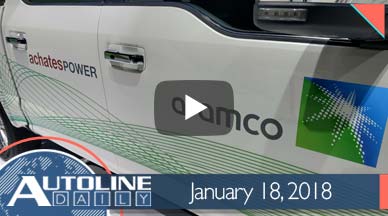
Runtime: 7:47
0:28 Achates Claims Engine Delivers 37 MPG in F-150
1:33 GAC’s Trumpchi Brand Not for the U.S.
2:51 AVs Produce Unprecedented Amount of Data
3:38 Mazda Still Sees Opportunities for Rotary Engine
4:59 Big Truck Sales Soar in America
5:54 PSA Outlines EV, AV & U.S. Plans
Visit our sponsors to thank them for their support of Autoline Daily: Bridgestone , Dow Automotive Systems and Lear Corporation.
On today’s show… PSA outlines plans to return to the U.S. and electrify its entire line-up… big truck sales continue to soar in the U.S… and Mazda still isn’t giving up on the rotary engine. All that and more coming right up on Autoline Daily.
This is Autoline Daily, your source for the latest news in the global automotive industry.
SAUDI OIL COMPANY HELPS PROMOTE ACHATES ENGINE
Well, here’s something we didn’t expect to see at the Detroit auto show. Aramco, the Saudi Arabian oil company has a display on the floor. And it’s promoting the Achates engine, mounted in a Ford F-150. It’s a 3-cylinder engine that uses 2 opposed pistons in each cylinder, so it’s actually a 3-cylinder, 6-piston engine. It also has a compression ratio of 18:1, does not have any spark plugs and runs on gasoline. Achates claims that in the F-150 it will deliver 37 miles to the gallon, combined, with highway fuel economy around 42 MPGs. And that’s based on the EPA test cycle. Achates says a major north American OEM is interested in the the 2.7 liter engine, which delivers 270 horsepower and 480 pound feet of torque. How interesting that with so much talk about electrification, here’s a Saudi Arabian oil company promoting an American-design that could be a breakthrough with the internal combustion engine.
TRUMPCHI BRAND NOT FOR THE U.S.
Speaking of the Detroit auto show, here’s an amusing juxtaposition of floor displays. Chinese automaker GAC is located right across the aisle from GMC. GAC, GMC– gee–only one letter apart. And the GAC stand is full of SUVs that will probably be priced at least $5,000 cheaper than anything from GMC. Just to add to the confusion, GAC has a van called the GM8. It also sells cars under a brand name called Trumpchi, which you can see at the end of the headlights. But GAC just announced it will not use the Trumpchi brand in the American market. Smart move. People who hate President Trump would never buy a car with that name. And the people who love Trump will never buy a Chinese car.
Still to come… Mazda says there’s still life left in the rotary engine.
THAT’S A LOT OF DATA
Want to know how much data a car can generate? Twitter’s 270 million users generate about 100 gigabytes of data a day. But a single autonomous car produces 3,000-times that, about 30 terabytes of data a day. But where do you store all this data? That’s a dilemma that automakers face, according to Wards Auto. Some of that data will be deleted, but automakers will have to hold on to a portion of data if only for liability reasons. Data storage requirements are going to be different for every company, but it is going to take time to figure out how to mine what’s useful and where to put it. And we point this out because there’s going to be a real opportunity to make a lot of money for anyone who figures out how to solve this problem.
ROTARY ENGINE COMEBACK?
Could the rotary engine make a comeback? Mazda’s still not giving up on the idea. Masahiro Moro, the president and CEO of Mazda North America says there’s a lot of opportunity for the engine. He expects a rotary range-extender will be used in Toyota’s e-Palette autonomous concept vehicle it debuted at CES. As Mazda continues to improve efficiency and quality of the engine, it could be used as generator to produce electricity or in fuel cell applications because it would only emit water. But Mazda’s not hanging its hat completely on internal combustion vehicles. Moro says the company is working on its own EV and that it will come to the U.S. around 2020.
Coming up next, Peugeot says Opel engineers will be key in its return to the U.S. market.
BIG TRUCK SALES SOAR
Even though sales of light vehicles declined slightly last month in the American market, big trucks ended the year with a bang. WardsAuto reports that medium and heavy-duty truck sales soared nearly 25% in December in the U.S. Class 4 through 7 were up 6% last month and the segment posted a 7% gain for all of 2017. Sales of the big Class 8 trucks skyrocketed 50% in December but due to a slow start to the year, they were down slightly overall in 2017. Medium and heavy truck sales topped 415,000 units for all of 2017, which is a 3.5% gain compared to 2016. And the story was the same north of the border. Big truck sales in Canada soared 45% in December and overall in 2017 medium and heavy duty sales were up a strong 17%.
PSA OUTLINES EV, AV & U.S. PLANS
It seems like every day, an automaker announces plans to electrify its line-up. Yesterday it was Infiniti and today its French automaker PSA, the parent company of Peugeot and Citroen. According to Reuters, CEO Carlos Tavares announced that by 2025 every model in the PSA Group will have an electric or hybrid variant. He also revealed that by 2030, 80% of its models will have semi-autonomous capabilities and 10% will be fully self-driving. Tavares also shared more details about Peugeot’s return to the U.S. The company is currently offering ride sharing services in the country through its Free2Move app. The next step is to add Peugeot vehicles to the service. And the final step, is to sell Peugeot vehicles in the U.S. created by Opel engineers. PSA acquired the German automaker from General Motors last year and Tavares says the engineers are familiar with U.S. regulations and customer tastes, having worked for GM. And he thinks this will help Peugeot with its return to the American market.
And a quick programming note, there will not be a new Autoline After Hours this afternoon. But John and Gary will be back next Thursday, with some of the best insider talk in the automotive industry.
And if you haven’t done so yet, be sure to check out our coverage of the Detroit auto show. We talked to automakers and suppliers about their latest reveals, newest technology and how new trends are impacting the industry. Look for that on our website or on our YouTube channel.
But that wraps up today’s show, thanks for watching and please join us again tomorrow.
Thanks to our partner for embedding Autoline Daily on its website: WardsAuto.com

John McElroy is an influential thought leader in the automotive industry. He is a journalist, lecturer, commentator and entrepreneur. He created “Autoline Daily,” the first industry webcast of industry news and analysis.




